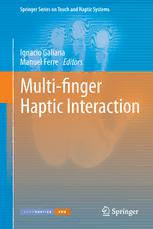Table Of ContentMulti-finger Haptic Interaction
Springer Series on Touch and Haptic Systems
SeriesEditors
ManuelFerre
MarcO.Ernst
AlanWing
SeriesEditorialBoard
CarloA.Avizzano
JoséM.Azorín
SoledadBallesteros
MassimoBergamasco
AntonioBicchi
MartinBuss
JanvanErp
MatthiasHarders
WilliamS.Harwin
VincentHayward
JuanM.Ibarra
AstridKappers
AbderrahmaneKheddar
MiguelA.Otaduy
AngelikaPeer
JeromePerret
Jean-LouisThonnard
Forfurthervolumes:
www.springer.com/series/8786
Ignacio Galiana (cid:2) Manuel Ferre
Editors
Multi-finger
Haptic Interaction
Editors
IgnacioGaliana ManuelFerre
CentreforAutomationandRobotics CentreforAutomationandRobotics
UPM-CSIC UPM-CSIC
UniversidadPolitécnicadeMadrid UniversidadPolitécnicadeMadrid
Madrid,Spain Madrid,Spain
ISSN2192-2977 ISSN2192-2985(electronic)
SpringerSeriesonTouchandHapticSystems
ISBN978-1-4471-5203-3 ISBN978-1-4471-5204-0(eBook)
DOI10.1007/978-1-4471-5204-0
SpringerLondonHeidelbergNewYorkDordrecht
LibraryofCongressControlNumber:2013939584
©Springer-VerlagLondon2013
Thisworkissubjecttocopyright.AllrightsarereservedbythePublisher,whetherthewholeorpartof
thematerialisconcerned,specificallytherightsoftranslation,reprinting,reuseofillustrations,recitation,
broadcasting,reproductiononmicrofilmsorinanyotherphysicalway,andtransmissionorinformation
storageandretrieval,electronicadaptation,computersoftware,orbysimilarordissimilarmethodology
nowknownorhereafterdeveloped.Exemptedfromthislegalreservationarebriefexcerptsinconnection
with reviews or scholarly analysis or material supplied specifically for the purpose of being entered
and executed on a computer system, for exclusive use by the purchaser of the work. Duplication of
this publication or parts thereof is permitted only under the provisions of the Copyright Law of the
Publisher’slocation,initscurrentversion,andpermissionforusemustalwaysbeobtainedfromSpringer.
PermissionsforusemaybeobtainedthroughRightsLinkattheCopyrightClearanceCenter.Violations
areliabletoprosecutionundertherespectiveCopyrightLaw.
Theuseofgeneraldescriptivenames,registerednames,trademarks,servicemarks,etc.inthispublication
doesnotimply,evenintheabsenceofaspecificstatement,thatsuchnamesareexemptfromtherelevant
protectivelawsandregulationsandthereforefreeforgeneraluse.
Whiletheadviceandinformationinthisbookarebelievedtobetrueandaccurateatthedateofpub-
lication,neithertheauthorsnortheeditorsnorthepublishercanacceptanylegalresponsibilityforany
errorsoromissionsthatmaybemade.Thepublishermakesnowarranty,expressorimplied,withrespect
tothematerialcontainedherein.
Printedonacid-freepaper
SpringerispartofSpringerScience+BusinessMedia(www.springer.com)
Series Editors’ Foreword
Thisistheseventhvolumeofthe“SpringerSeriesonTouchandHapticSystems”,
whichispublishedinacollaborationbetweenSpringerandtheEuroHapticsSo-
ciety.
Multi-finger Haptic Interaction is focused on characterizing and reproducing
multi-finger object grasping actions. The growing importance of this endeavour is
demonstratedbypotentialroboticapplicationssuchasobjecttransportandmanipu-
lationtasksaswellasgrowingrecognitionoftheneedtoeffecthandoverofobjects
betweenrobotsandhumanswherethemulti-digitnatureoftheindividualandcom-
binedgraspsiscriticaltosuccess.
Thecontributionsinthisbookincludeanoverviewoftheavailabletechnologies
for multi-finger haptic interaction, a description of mechanical design and control
issues, development of methods to allow multiple contact points when interacting
with virtual scenarios, specification of techniques to allow bimanual manipulation
andreportsonhumanperceptionstudies.Overallthesestudiesofferakeytounder-
standinghowmulti-fingerhapticfeedbackimprovestherealismandperceptionfor
avarietyofdifferentapplications.
The editors of Multi-finger Haptic Interaction are Ignacio Galiana and Manuel
Ferrewhohaveextensiveexperienceinthefield.Galianaisresearchengineerand
PhD candidate at the Centre for Automation and Robotics UPM-CSIC. Ferre is
professorandvice-directoroftheCentreforAutomationandRoboticsUPM-CSIC.
HeisalsooneoftheEditorsoftheSpringerSeriesonTouchandHapticSystems.
ThebookaroseoutofGalianaandFerre’sjointinterestsindevelopingmulti-finger
hapticdevicesandmethodsforenhancedimmersioninsimulatedenvironmentsand
remote handling and an international conference workshop they organised at the
EurohapticsmeetinginFinlandin2011.
March2013 MarcErnst
AlanWing
v
Contents
1 Introduction . . . . . . . . . . . . . . . . . . . . . . . . . . . . . . . . 1
IgnacioGalianaandManuelFerre
2 Multi-fingerGraspsinaDynamicEnvironment . . . . . . . . . . . . 5
WilliamHarwinandAlastairBarrow
3 3D Interaction Techniques for Bimanual Haptics in Virtual
Environments . . . . . . . . . . . . . . . . . . . . . . . . . . . . . . . 31
AnthonyTalvas,MaudMarchal,GabrielCirio,andAnatoleLécuyer
4 Modular Multi-finger Haptic Device: Mechanical Design,
ControllerandApplications . . . . . . . . . . . . . . . . . . . . . . . 55
IgnacioGaliana,JorgeBarrio,JoseM.Breñosa,andManuelFerre
5 HIRO:Multi-fingeredHapticInterfaceRobotandIts Medical
ApplicationSystems . . . . . . . . . . . . . . . . . . . . . . . . . . . 85
HaruhisaKawasaki,TakahiroEndo,TetuyaMouri,YasuhikoIshigure,
andVytautasDaniulaitis
6 Two-HandedMulti-fingerString-BasedHapticInterfaceSPIDAR-8 109
KatsuhitoAkahane,JungwooHyun,ItsuoKumazawa,andMakotoSato
vii
Contributors
KatsuhitoAkahane TokyoInstituteofTechnology,Midori,Yokohama,Japan
Jorge Barrio Centre for Automation and Robotics UPM-CSIC, Universidad
PolitécnicadeMadrid,Madrid,Spain
AlastairBarrow ImperialCollege,London,UK
Jose M. Breñosa Centre for Automation and Robotics UPM-CSIC, Universidad
PolitécnicadeMadrid,Madrid,Spain
GabrielCirio IRISA/INRIA,Rennes,France
VytautasDaniulaitis UABAksonas,Kaunas,Lithuania
TakahiroEndo GifuUniversity,Gifu,Japan
Manuel Ferre Centre for Automation and Robotics UPM-CSIC, Universidad
PolitécnicadeMadrid,Madrid,Spain
Ignacio Galiana Centre for Automation and Robotics UPM-CSIC, Universidad
PolitécnicadeMadrid,Madrid,Spain
WilliamHarwin SchoolofSystemsEngineering,UniversityofReading,Reading,
UK
JungwooHyun TokyoInstituteofTechnology,Midori,Yokohama,Japan
YasuhikoIshigure MarutomiSeikoCo.,Ltd.,Seki-shi,Gifu,Japan
HaruhisaKawasaki GifuUniversity,Gifu,Japan
ItsuoKumazawa TokyoInstituteofTechnology,Midori,Yokohama,Japan
AnatoleLécuyer IRISA/INRIA,Rennes,France
MaudMarchal IRISA/INRIA/INSA,Rennes,France
ix
x Contributors
TetuyaMouri GifuUniversity,Gifu,Japan
MakotoSato TokyoInstituteofTechnology,Midori,Yokohama,Japan
AnthonyTalvas IRISA/INRIA/INSA,Rennes,France
Chapter 1
Introduction
IgnacioGalianaandManuelFerre
Abstract Real-life interactions involve dexterous manipulation with multiple fin-
gers and palm; however, most commercially available devices allow haptic inter-
action with only one contact point. In this book, we provide a panoramic state of
the art of current developments in the fields of Multi-finger Haptic Technologies,
multi-contact point simulation algorithms, interaction techniques and implications
in human perception. This introductory chapter provides motivation for develop-
ing haptic technologies and methods with multiple fingers followed by a detailed
descriptionofchapterscomposingthisbookissue.
Multi-finger Haptic methods provide a realistic and natural human-machine inter-
face that enhances immersion when interacting with simulated or remote environ-
ments.Thisissueprovidesapanoramicstateoftheartofmethodsformulti-finger
hapticinteraction.Implicationsofaddingmultiple-fingerstohapticperceptionare
alsoanalyzed.Topicscoveredinthisissueinclude:designandcontrolofadvanced
haptic devices; multi-contact point simulation algorithms, interaction techniques
andimplicationsinhumanperceptionwheninteractingwithmultiplefingers.These
multi-disciplinaryresultsareintegratedintoapplicationssuchasmedicalsimulators
fortrainingmanualskills,simulatorsforvirtualprototyping,precisemanipulations
inremoteenvironments,andcontrolofrobotichands.
Mostcommercialdevicescurrentlyavailableallowhapticinteractionwithonly
onecontactpoint,whichmaybesufficientforsomeexplorationorpalpationtasks;
however,multi-contactpointapplicationsallowperformingmoreadvancedandre-
alistic object manipulation such as grasping or assembling. The realism of multi-
contactpointapplicationsissignificantlyhigherthantheclassicalone-contactpoint,
sincethewaysweareusedtointeractinginourdailylives(usingatoothbrush,open-
ingdoors,usingcell-phones,playingbasketball,etc.),orinprofessionalsituations
I.Galiana(B)·M.Ferre
CentreforAutomationandRoboticsUPM-CSIC,UniversidadPolitécnicadeMadrid,
C/JoséGutiérrezAbascal2,28006Madrid,Spain
e-mail:[email protected]
M.Ferre
e-mail:[email protected]
I.Galiana,M.Ferre(eds.),Multi-fingerHapticInteraction, 1
SpringerSeriesonTouchandHapticSystems,DOI10.1007/978-1-4471-5204-0_1,
©Springer-VerlagLondon2013

